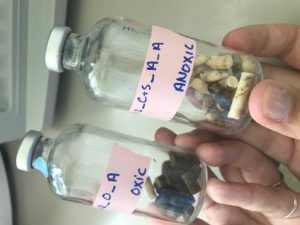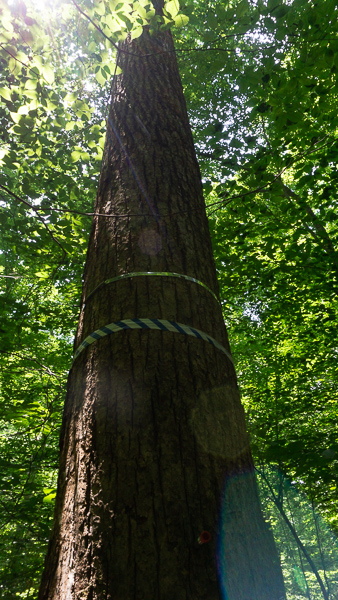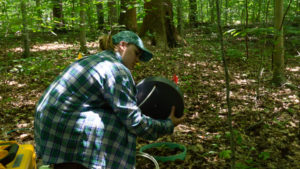By Philip Kiefer
Until a decade ago, scientists believed forests were ravenous consumers of methane, a potent greenhouse gas. But we’re discovering that the story is more complicated. It turns out that while forest soils absorb methane, trees might actually release the gas. The problem is, no one is sure how much methane the trees are producing, or why they’re producing it at all.
“We’ve seen anything from 5 percent to 100 percent offset,” says Paul Brewer, a postdoctoral fellow at the Smithsonian Environmental Research Center (SERC). That’s an enormous amount of uncertainty: The forest could be consuming as much methane as we once thought (almost all of it), or barely any at all.
SERC Intern Helps Pin Down Numbers
Maddie Peterson, an intern working for Brewer at the SERC Biogeochemistry Lab, is spending her summer trying to pin these numbers down.
She’s working to solve two questions. First, how much methane is an average tree releasing? And second, why is it doing so at all?
“The big question,” says Peterson, “is whether the trees are acting as straws” – siphoning methane up from deep in the earth – “or incubators” – cradling methane-producing bacteria in their trunks. Answering these questions will help scientists understand how methane moves in and out of the atmosphere, which is critical for predicting the course of climate change.
Methane is a greenhouse gas 25 to 45 times more powerful than carbon dioxide over the course of a century. It’s produced in low-oxygen environments: deep under the Arctic tundra, in wetlands, and in the guts of animals. Natural gas also emits a hefty amount of methane during its production and transport.
Many kinds of soil absorb methane, breaking it down into carbon dioxide. Forest soils are superlative at this.
“Forest soils absorb the most methane of all ecosystems,” says Brewer. This is in part because the forest floor is full of bacteria that eat methane, called methanotrophs. Over time, they break down atmospheric methane, storing it in the soil as carbon.
The process isn’t entirely one-way. Deeper in the soil, where there’s less oxygen, different bacteria called methanogens produce methane as they eat. But as long as the soil isn’t flooded with water, which would cut off oxygen, methanotrophs in the shallow soil consume all of that methane, and the soil as a whole absorbs the gas.
But this methane absorption may be completely offset by methane released from trees.
Scientists at Yale first discovered that trees release methane about 10 years ago, when they noticed that diseased trees were releasing the greenhouse gas. That prompted others to inspect methane emissions from unexpected forest sources, which lead to a more nuanced portrait of the forest.
“We’re finding that even healthy trees produce methane, not just the obviously diseased ones,” says Brewer. That’s why there’s so much uncertainty about the methane balance of forests – scientists are still working out how much methane healthy trees can emit. If methane release is a normal part of a tree’s life, then forest methane emissions are likely much higher than we believed.
Watching Forest Bacteria Breathe
Brewer and Peterson monitor the emissions of a stand of tulip poplars in the SERC forests. In the stand, hoses sprout from the most surprising places: straight out of the forest floor, or from the bark of a tree at chest height. The hoses reach up to three feet underground, or deep into the trunks of the trees, allowing Peterson and Brewer to sample the air from different bacterial ecosystems.
They’ve noticed some remarkable things happening inside the trees. “There’s around 30 to 40 percent pore space in wood, some of which is water and some of which is gas,” Brewer says, “and we’ve found trees where 50 percent of the gas is methane.” That suggests that virtually all of the bacteria in such trees are producing methane.
“You can actually take some of these trees, drill a tap into the side, and light the gas that comes out of the tap,” says Brewer.
The hoses allow Peterson and Brewer to see how much methane each tree is producing. But it doesn’t help them see if the trees are “straws” or incubators.
To answer that question, Peterson has to examine the wood itself—or rather, the things that live inside it. She has sampled dozens of wood cores from the test site. Trees have roughly four layers of wood under their bark: Two exterior layers that transport sugar and water, and a two-layer core made of heartwood and some rotten tissue. Like the forest soil, the wood probably harbors different types of bacteria.
Watch: Trees screech when a core sample is taken. The friction of the wood causes the coring drill to vibrate and heat up as it’s driven into the tree’s center.
“We think that more producers are inside, and consumers live on the outside,” she says. So she separates the inner and outer layers, and incubates the cores overnight in sealed containers. If methane producers live in the cores, she’ll find more methane in the containers in the morning. But if methane consumers are present instead, the methane will disappear.

The tree cores, and the microbes living within, are subjected to different atmospheric conditions to see whether they produce or consume methane.
She’s also studying how methane moves through wood using a special type of “labelled” methane they create in lab – “more valuable than gold,” according to Peterson. By following the progress of the labelled methane through the wood, she can watch as the bacteria inside breathe and grow, giving her a lens into how methane cycles inside the trunk before reaching the atmosphere.
These techniques can tell Peterson if the trees are in fact acting as incubators: If the cores are producing methane, she has a smoking gun. There methanogens are in there. But it’s harder to test the “straw” hypothesis if the wood isn’t producing methane.
To see if a tree is acting as a straw, “you largely have to rely on circumstantial evidence,” says Brewer. “We would have to find the actual source of the methane, so we look for methane in the ground and groundwater.”
“And then there’s always the possibility that a tree can be both a straw and an incubator!” he adds. More than likely, the trees are some combination of the two. In methane-rich environments, like swamps, trees may pump buried gas into the atmosphere. In other forests, trunk-based bacteria may be the primary culprits.
So Trees Might Produce Methane. What Does that Mean for the Climate?
Brewer recognizes that this research could change how we understand the climate benefits of forests, which naturally has political implications. When asked if there’s a risk their findings could be taken out of context, he said, “I think it’s almost inevitable.”
“I think the takeaway should be basically that forests aren’t as good as we thought,” he says. But that’s not to say that forests don’t act as carbon sinks – simply that they’re not the cure-all that some people make them out to be. Averting global climate change will take more than just planting forests.
Related:
Surprising Tree Emissions Show Forests Consume Less Methane Than Thought



